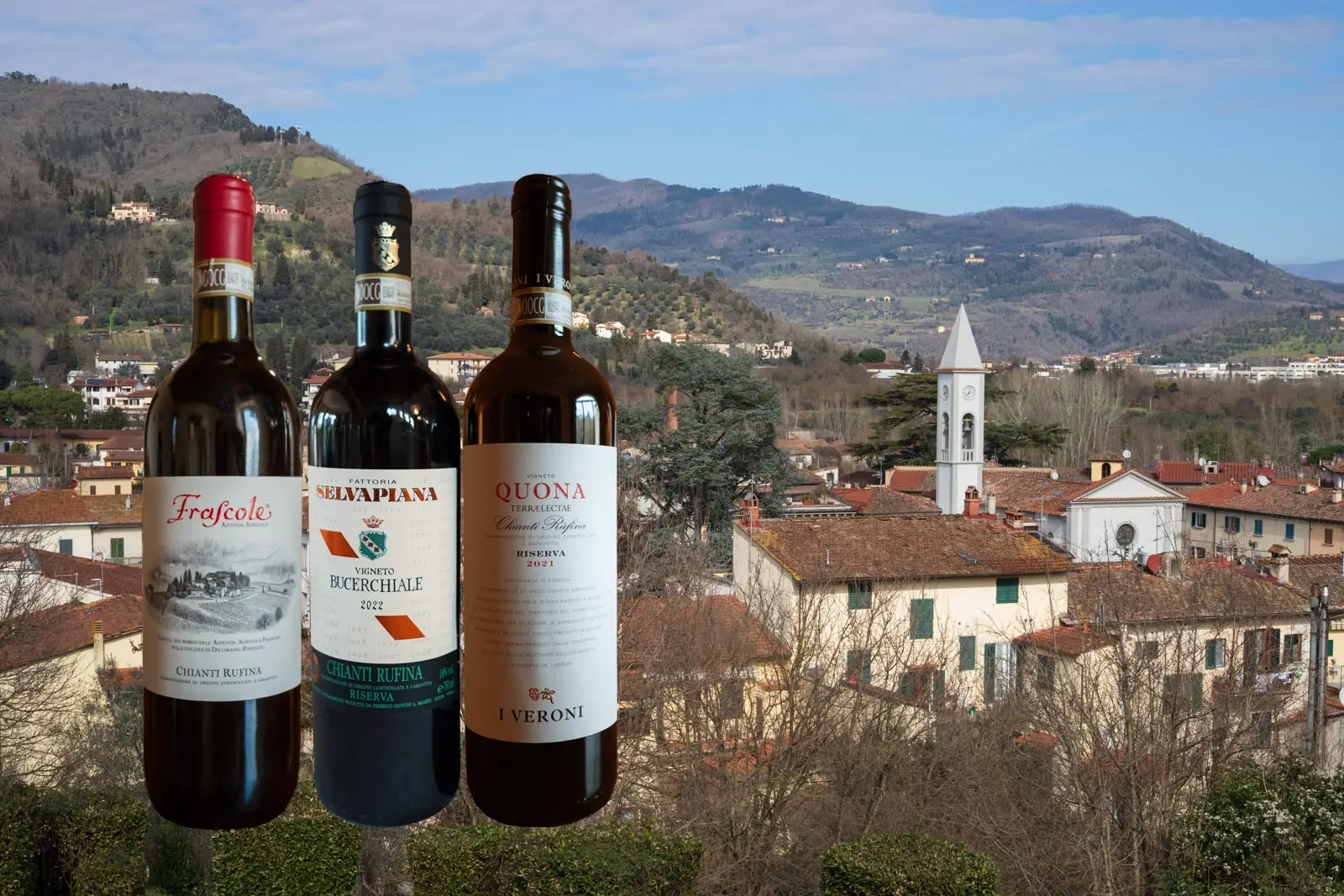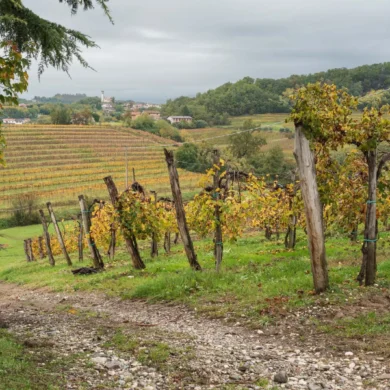When you think about Tuscan wine, you invariably think about Sangiovese, a grape that accounts for roughly 60-65% of Tuscany’s vines. This dominance used to mean quite a bit of sameness, but not anymore. With a better scientific understanding of soil and grape clones, producers across Tuscany are answering the call from fine wine enthusiasts to let the terroir shine. Few places demonstrate this trend as well as Chianti Rùfina, which today remains Tuscany’s best kept secret as far as wine regions go.
“We often make this joke here, that Rùfina is the Burgundy of Tuscany. Then we look at our bank account, and we’re still clearly Rùfina!”
Federico Giuntini Masseti
Winemaker, Fattoria Selvapiana
The area is an idyllic landscape of bulky, forested mountains and gentle streams, which yields wines of both concentrated power and freshness — a combination you don’t often find in red wines. The one thing Chianti Rùfina lacks in comparison to the more famous Chianti Classico is a kind of modern-day rhapsodizing from wine’s most influential voices. It remains an insider’s pick (maybe that’s why I love it so much). Here is a zone that exalts Sangiovese like few others, and its modest prices make it an attractive buy in this economic climate.
I’ve felt this way for several years, but had never given the region its proper due with a First-Taste Guide. So earlier this year, I traveled back to the region, camera in hand, and spent the day with a man who knows this place as well as anyone: Federico Giuntini Masseti of the beloved Chianti Rùfina estate Fattoria Selvapiana. Together, we also visited Frascole and I Veroni, and I spoke with Gerardo Gondi, the President of the Consorzio Chianti Rùfina.
“We often make this joke here, that Rùfina is the Burgundy of Tuscany,” Giuntini Masseti told me when discussing the region’s signature elegance. “Then we look at our bank account, and we’re still clearly Rùfina!”
What the visit revealed to me was a soulful slice of Tuscany that will likely never suffer from overtourism, but which is steadily increasing its stature with wine professionals in-the-know.
Let’s pull back the curtain on one of Central Italy’s greatest wine terroirs.
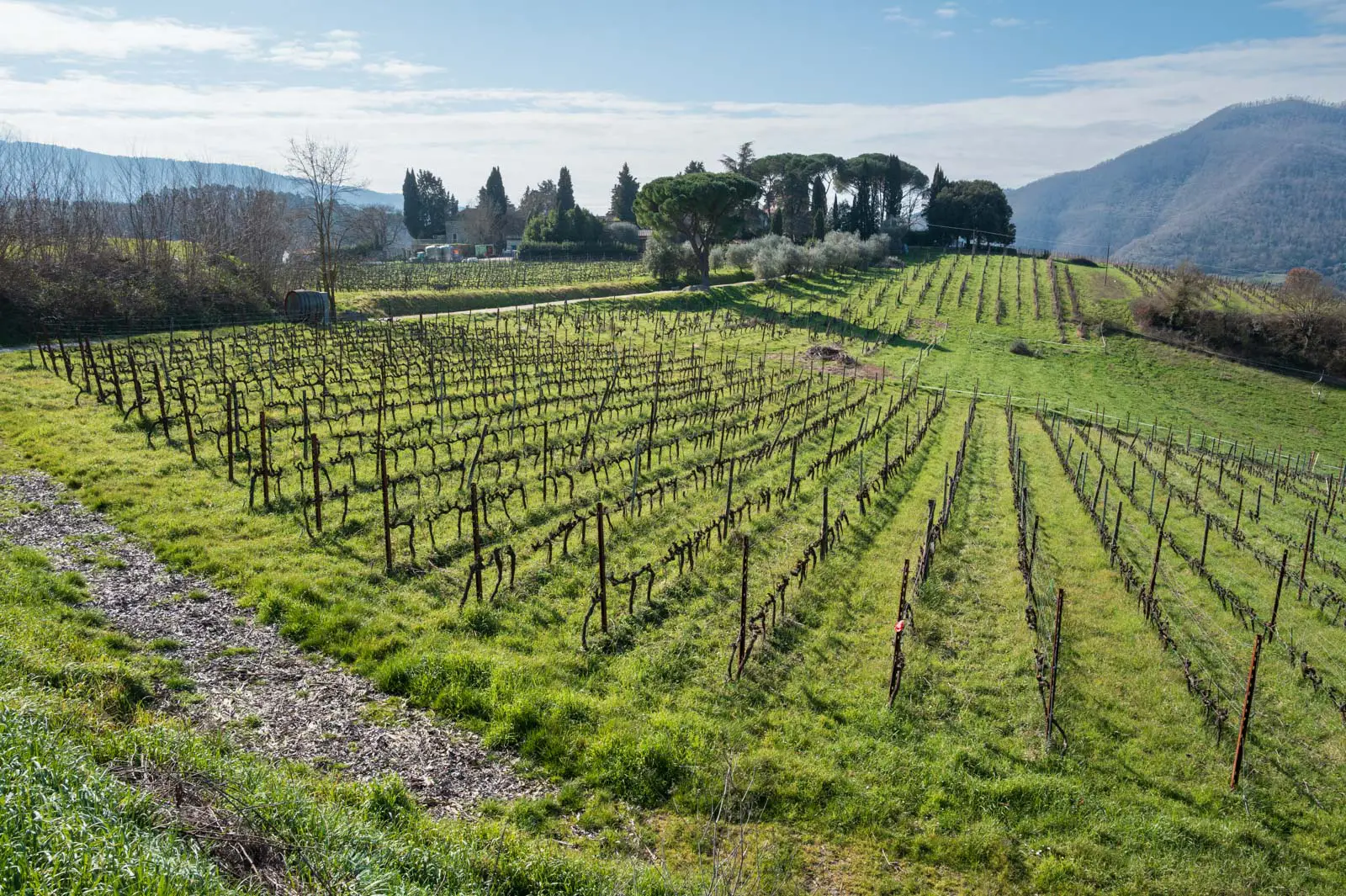
3 Reasons to Try Chianti Rùfina
- You Want Something Else to Compare to Brunello di Montalcino and Chianti Classico – There is no question that these two appellations produce many of Italy’s greatest Sangiovese wines. Is there room atop the pedestal for one more? I would say yes.
- You Are Looking to Pad Your Italian Wine Collection – Chianti Rùfina should be an ace-up-the-sleeve for anyone with an Italian-focused collection. It is an age-worthy, structured red wine at a reasonable price. I am not here to dissuade Brunello or Chianti Classico fans from stocking their shelves with those classics; rather, I’d urge a complement of Chianti Rùfina, too. Learn more about my Wine Cellar Consultation Services.
- You Seek Intimacy with the Landscape Behind Your Wine – Chianti Rùfina has the hills, the forest and the rural grape-and-olive idylls to match the aesthetic of Chianti Classico, but it also has two grand rivers, the Sieve and Arno, and it lies well off-the-beaten tourist path. It’s quite an image to conjure when you have it in your glass.
What is Chianti Rùfina?
Chianti Rùfina is the smallest subzone by vineyard acreage of the overarching Chianti DOCG appellation. This appellation is distinctly different from the Chianti Classico DOCG, which regulates wines from the historic heart of Tuscany where Sangiovese blends became famous. As an outsider, I often feel like it is best to view Chianti Rùfina as though it were a distinct appellation, even if technically it is not. That’s because unlike the other subzones of the Chianti DOCG, Chianti Rùfina has tremendous historical significance and a very clear identity.
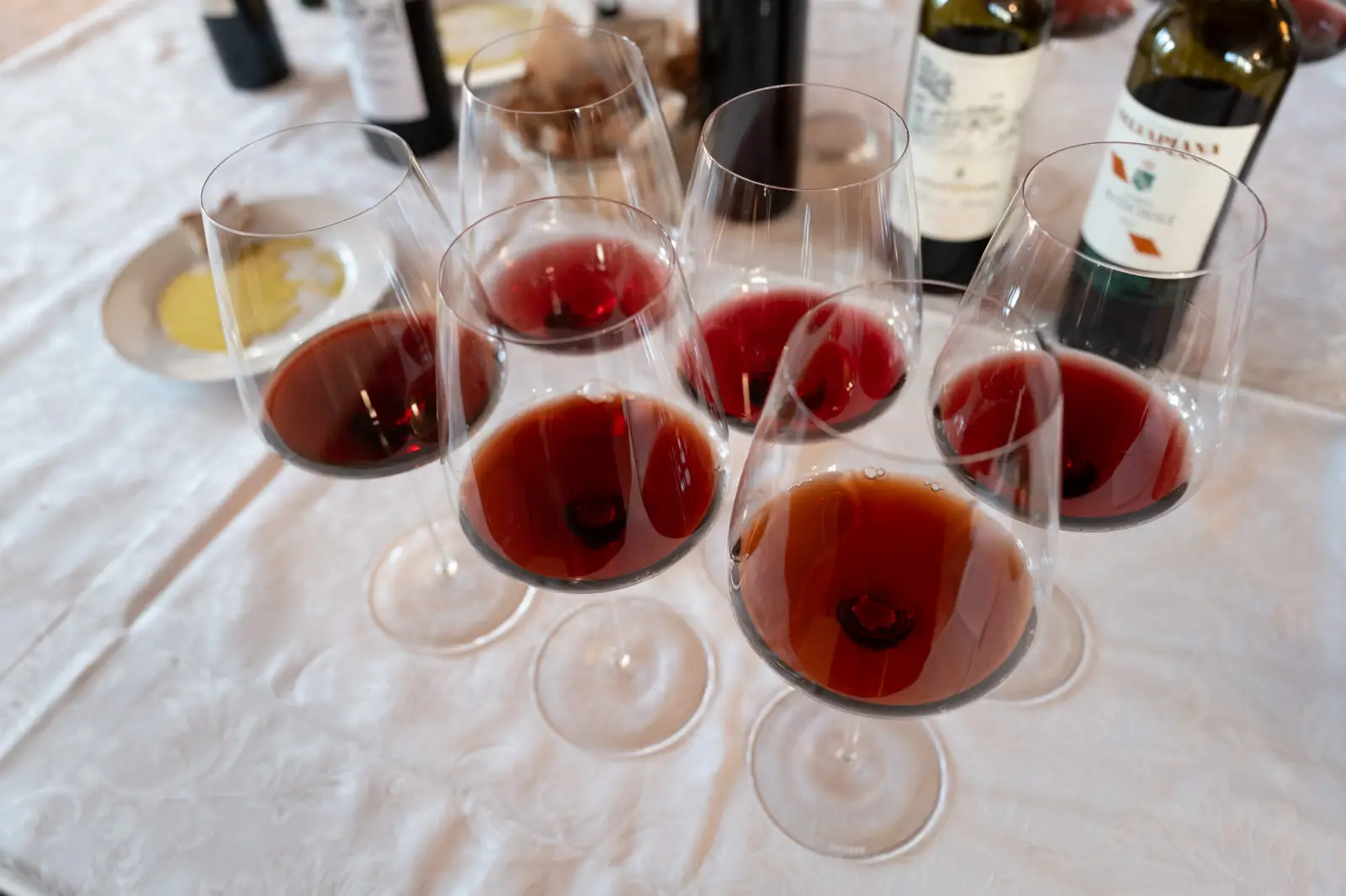
All wines must come from within the subzone’s designated boundaries, which surround the communities of Rùfina, Pontassieve, Dicomano, Londa and Pelago in northeastern Tuscany.
There are three categories of Chianti Rùfina wines, and I recommend one wine per category below.
Ease and Grace: Chianti Rùfina
The annata or annual wine is the standard bearer, and is labeled merely as Chianti Rùfina. These wines are released every year and sold at the most affordable price point. They need to be at a minimum 70% Sangiovese with a smattering of other allowable red and white grapes to round out the rest of the blend. In practice, these wines are usually varietal Sangiovese or close to it. Together, Cabernet Sauvignon and Cabernet Franc cannot exceed 15% of the blend. White grapes, though rarely used, cannot comprise more than 10% of the blend. These wines cannot be released before September 1 of the year following harvest.
Stature and Poise: Chianti Rùfina Riserva
One level up, you will find Chianti Rùfina Riserva. These wines must be include 90% Sangiovese in the blend (many are varietal anyway) with the remaining balance being comprised of only the sanctioned red wine grapes of the area (e.g. Colorino, Canaiolo, Merlot, etc.). Just as importantly, the wine must be aged for two years before release, with a mandated 6 months in oak barrels.
Terroir-Specificity: Chianti Rùfina Riserva Terrælectae
A new category, called Chianti Rùfina Riserva Terrælectae, is reserved for the most outstanding and exceptional single-vineyard Riserva wines of the area. Unlike the other categories, Terrælectae must be 100% Sangiovese, and aged for a minimum of 30 months (of which 18 of those must be in oak, while 6 months must be in bottle).
Avoid the Confusion!
One of Italy’s largest winery brands, Ruffino, has a very similar name to Chianti Rùfina.
- Rùfina = subzone of Chianti
- Ruffino = wine brand
To make matters more confusing, Ruffino produces five Chianti Classico wines plus two wines under the Chianti DOCG, but not a single Chianti Rùfina. While annual production numbers for Ruffino’s Chianti wines are not publicly available, given Ruffino’s total production of roughly 29 million bottles per year, it is reasonable to infer that they produce substantially more Chianti than the entire Chianti Rùfina subzone combined.
Translation: you are more likely to see a Chianti of some sort from Ruffino on the shelf than a Chianti Rùfina. It is an important distinction.
About the Subzone and Its Wines
Chianti Rùfina is located roughly 10 miles east of Florence, where the Sieve River flows out of the Toscan-Romagnolo Appennines to join the Arno. Vineyards are heavily concentrated in the southern end of the zone, particularly around Pontassieve and Pelago, but there are also scattered plots up into the mountains around Rùfina and Dicomano. As with Chianti Classico and Brunello di Montalcino, the higher elevation vineyards tend to yield crisper wines, while those from the lower elevations are more robust.
The History
Chianti Rùfina’s history is closely tied to the Medici’s, the political dynasty that ruled Florence for centuries. In 1716, Cosimo III de’Medici issued an edict known as the Bando which set about protections for wine producing areas under his governance. They included what is now known as Chianti Classico, as well as Carmignano, Valdarno di Sopra and Pomino. Pomino included Rùfina, although it should be noted that the Pomino DOC is today a separate, smaller appellation for white and red wine blends.
“The only part that was called ‘Chianti’ back in the days was the historical part, what we now call Chianti Classico,” Federico Giuntini Masseti told me as we drove up the Sieve River into the heart of Rùfina. “So that was Castellina, Radda, Gaiole and Greve in the mountains between Florence and Siena.”

From the Chianti Classico region came a blended wine with Sangiovese at the forefront, and — taking note — other regions in the vicinity began to loosely follow the formula. Chianti the Place became Chianti the Product, and by 1967, all of it would be protected as an appellation of unique origin under Italian law going by the name Chianti. (Chianti Classico would be granted its own DOCG in 1996).
“I have a friend in Gaiole who jokes that we are the ‘stolen Chianti,’” Masseti noted. While there is some truth that imitation is the most sincere form of flattery, in the case of Rùfina and Pomino, the grapes used in the Chianti formula were just as historic to their zone as to Chianti Classico. It was the proportions and how they were employed in the blend that mattered.
In the 19th century, French grapes were introduced to the area, and little Pomino — an isolated, high-elevation village east of Rùfina whose name once covered the broader area under the Bando — would become better known for blends using those grapes. The historic Sangiovese expression of the area would go under the name of Chianti Rùfina.
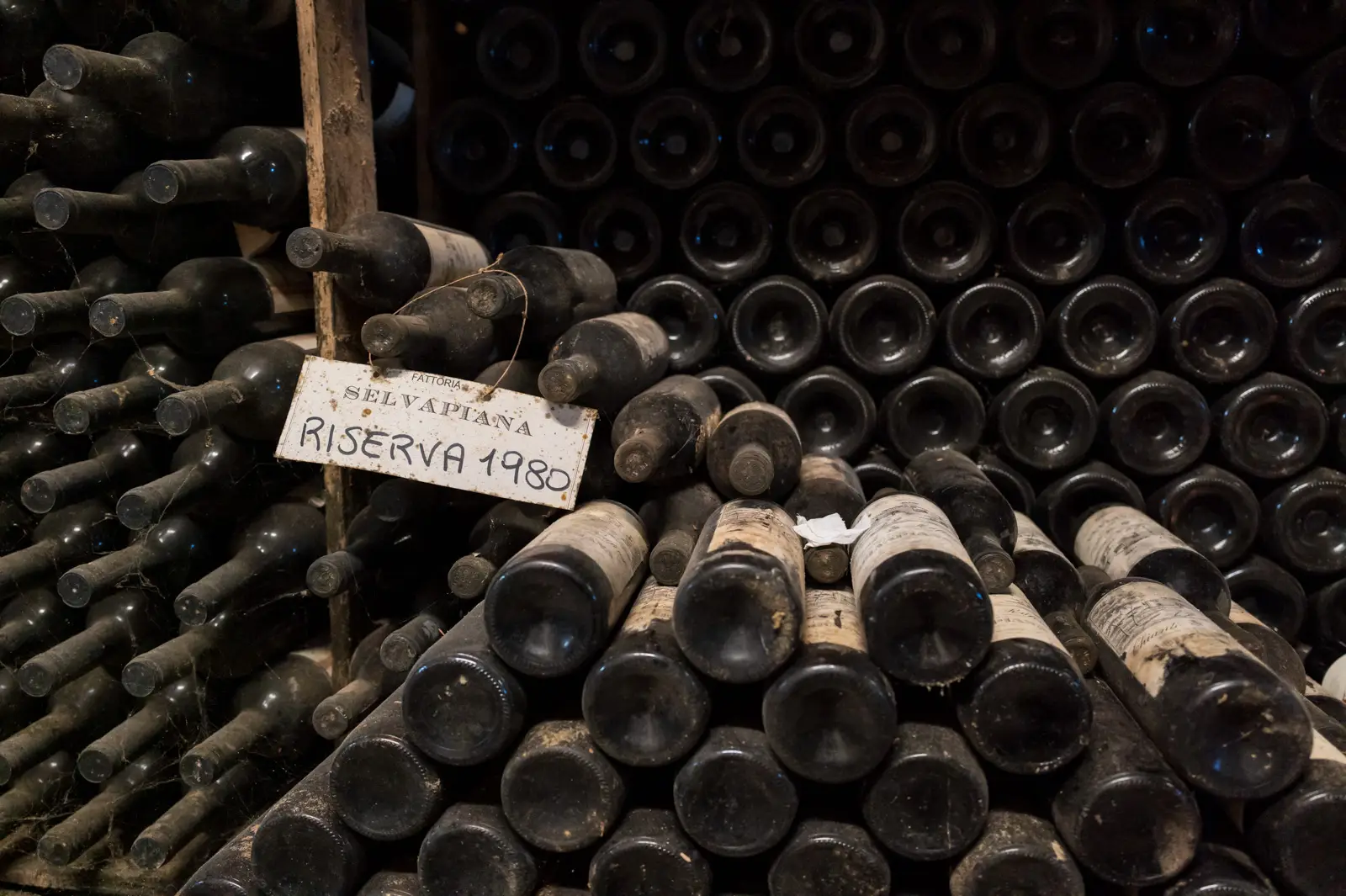
But the 20th century would pose the biggest challenge to Chianti Rùfina’s viticultural economy.
A few nights earlier in Florence — at a focused wine dinner devoted to Chianti Rùfina’s new category of Terrælectae wines — Gerardo Gondi of the estate Marchesi Gondi spoke of this moment in Rùfina’s history.
“We were like the Burgundy of Tuscany in terms of innovation and the study of viticulture,” Gondi said of the region’s reputation in the early 20th century. But because of Chianti Rùfina’s strategic location along the Arno River, it became a fiercely fought-over piece of land during World War II. This was nothing new for Chianti Rùfina — it had long been a battlefront throughout its history — but the scale of the bombardment was unprecedented. “We had to restart everything, but there were around 70 bottlers and the quality was low. The price [of Chianti Rùfina] diminished by the 1960s, and it collapsed our economy.”
It has been a slow and steady climb back to prestige for the producers of Chianti Rùfina. The region’s small size has made it hard to draw attention in the sea of Tuscany’s red wines, but it is perhaps the subzone’s brand confusion — both with the broader Chianti category as well as the Ruffino winery (see note above) — that has proved to be the biggest obstacle.
But, Gondi noted, Chianti Rùfina has one important competitive edge: the climate.
“In my opinion, the thing that distinguishes our wines is the elegance,” he said. “And that comes directly from our mountain terroir and cooler climate.”
The Terroir
Back on the road, Giuntini Masseti wanted to illustrate to me the range of terroir in Rùfina, so he drove me to the stunning vineyards of Frascole high in the mountains above Dicomano. Here, we met his friend Enrico Lippi for an impromptu tasting, but first we had to take in the views of forest, vine and orchard. Lippi came to the area with his wife in 1992 with a passion for gardening. In addition to managing 15 hectares of vines, he also cultivates peaches.
“We have a different climate up here. It is more cold at night, and we pick five or seven days later than the rest of Rùfina.” Lippi said. “And these cool nights have been good with these warmer vintages.” Like Chianti Classico, Chianti Rùfina boasts large stands of protected woodlands, which help to regulate the microclimates around them, and preserve biodiversity.
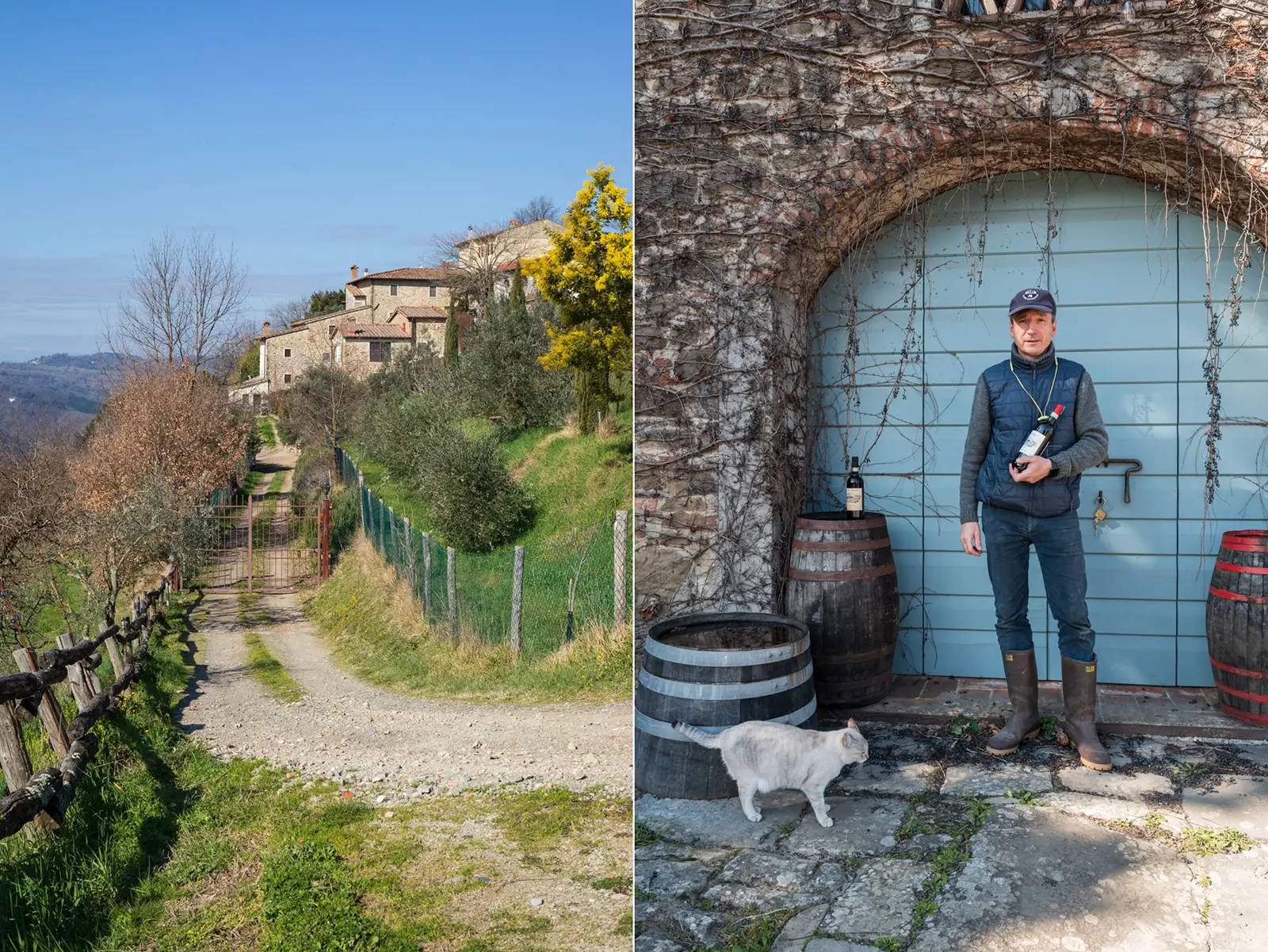
Additionally, the higher elevations have more limestone while the lower slopes have more clay, translating into more finesse and more power respectively. Some slopes boast the famed galestro soil, a type of white schist that gives Sangiovese a sense of verve on the palate. Because the variations of soil and climate can be so drastic in these hills, many producers have adapted to micro-vinifications that are later blended. At Frascole for instance, Lippi says that he can perform upwards of 30 different fermentations in order to get the best, most customized results from the terroir’s demands.
But, Giuntini Masseti noted, the right site for vines is a narrow window. “Rùfina can be too high in places,” he said. “And when it is too high, Sangiovese doesn’t ripen.”
Most of the vineyards lie in the lower end of the valley, on south-facing bench lands above the Arno River. Here, the climate and the presence of clay foster more power in the wine.
Another defining attribute of Chianti Rùfina’s terroir is its position farther from the Mediterranean and Adriatic Seas than any other Tuscan region. Because of this fully continental climate, the zone experiences greater differences in temperature between day and night, leading to balanced ripening and retention of acidity. But late spring frosts can be a major issue, especially for vineyards closer to the two rivers.
The Winemaking
Despite its many unique traits culturally, historically and geographically, Chianti Rùfina shares one key attribute with its Tuscan peers: winemaking.
The region follows a lot of the same best practices for harvest, fermentation and aging of Sangiovese as I’ve found in Chianti Classico. Differences often come down to barrel size and the length of bottle aging, but that varies more at the producer level than between subzones. I often prefer those aged in larger barrels because they impart very little oak influence, but there are exceptions. For instance, Frascole’s brilliant Chianti Rùfina Riserva is aged in a mix of used barriques and tonneaux, which winemaker Enrico Lippi feels is a better fit for his mountain fruit’s structure. The results are hard to argue with.

Additionally, producers are increasingly embracing Sangiovese as the one and only protagonist in their wines, a trend seen all over Tuscany in the last decade. Once seen as a prerequisite for global attention, the international Bordeaux varieties allowed in the blend are now given proper caution, as their assertive personalities can quickly steal the show from Sangiovese’s delicacy.
Finding These Wines
Each year, the subzone of Chianti Rùfina produces around 2.7 million litres of wine (roughly 3.5 million 750 mL bottles). Much of this is exported to the United States and other countries. For comparison sake, the Chianti Classico DOCG produces the equivalent of 35 to 38 million bottles. Still, in my opinion, availability is fairly good for these wines outside of Italy. You will have to do some hunting for the smaller independent wineries, as two wineries account for a significant portion of the subzone’s output.
The best-known estate in the area is Frescobaldi, which boasts nearly eight times the amount of Chianti Rùfina production as the second-largest winery in the zone, Fattoria Selvapiana. But despite that discrepancy in volume, the region’s wineries are banded together to “lift all boats” for the zone.
“They own one-third of the appellation, and they bottle half of the appellation’s wines,” Federico Giuntini Masseti told me as we drove into the hills. “But Lamberto Frescobaldi is really a great help for the consortium. And his wine, while often the first Chianti Rùfina wine that people taste, is really a great value and we all respect it very much.”
Cooperation and collaboration at the consortium level is not something everyday drinkers need to be concerned about, but I have to say, as a wine writer and educator focused on the overall quality of wines with a distinct origin, it is hugely important to the preservation of a region’s identity, and its adaptation to an uncertain future. From everything I’ve seen, Chianti Rùfina is in good hands.
So Which Wines Shall You Try?
Ready to uncork some bottles of Chianti Rùfina? My wine recommendations leave pointless point scores aside, and instead give you a compelling reason for buying each wine, no matter where you are on your wine journey.
If you join my community of curious beginners and passionate wine obsessives, you’ll unlock context-rich tasting reports, wine recommendations, and live and recorded wine classes, all focused on Italy and other European wine countries.
My Chianti Rùfina Recommendations
For your “first taste” of Chianti Rùfina, I have three suggestions for you, as well as a compendium list of five more wines to seek out should you be unable to find one of these three. A significant amount of the wine produced in this slice of Tuscany is by one estate: Frescobaldi. This aristocratic family’s legacy holdings at Castello Nipozzano are the most historic in their portfolio, and they account for roughly half of the appellation’s total output of wines. Therefore, Frescobaldi is the most likely wine you find, and both the Chianti Rùfina Riserva “Nipozzano” and the Chianti Rùfina Riserva Terrælectae “Vigna Montesodi” are solid candidates.
But we are explorers, eager to connect with the family stories of these regions. Having canvassed these wines at the Anteprima di Toscana for a few years — and having visited the appellation twice — these three standout to me as the best candidates for a “first taste” across each of the subzone’s categories.
2022 I Veroni “I Domi” Chianti Rùfina
Don’t be surprised if an entry-level Chianti Rùfina is the wine you want to return to for a second glass. That is common with Sangiovese, where the grape’s stern tannins and robust flavors tend to ratchet up the experience as you climb into the more exclusive wines.
The 2022 annata Chianti Rùfina from I Veroni is a great example of this. Offering dark cherry fruit and spearmint herbaceousness on the nose, it transitions on the palate into a slightly savory yet refreshing wine that can handle a wide variety of pairings and occasions. A very well-composed, well-mannered wine that speaks of this place brilliantly with that darker sense of fruit.
A beginner might like … hunting for the herbaceous notes, one of the four primary tones I seek when tasting Sangiovese (the others: red fruit, citrus, savory).
A wine obsessive might like … the incredible value of this sub-$20 wine. It might have you nostalgic for the early 2000s when you could often drink well below that price point.
2019 Azienda Agricola Frascole Chianti Rùfina Riserva
Enrico Lippi’s mountain-top estate exudes a special stamp on this gorgeous 2019 Riserva. The nose offers a sharpness to the fruit that seems light, promising a less full-bodied wine once on the palate. But those aromas do not sacrifice the meaty savoriness — a note I recently wrote down as “smoky/peppercorn” — that in my opinion brings Sangiovese to its high point. Indeed, once on the palate the wine is elegant because of this mountain terroir, running gracefully on a wave of citrus-like acidity. The flavors are even a bit earthy, with ample complexity and stony tannins.
A beginner might like … the obvious complexity of this wine. Sometimes the many layers of a wine can feel so tightly woven in youth that you can’t quite process them. Not here. If ever there was a wine to show novice drinkers of Chianti Rùfina how much Sangiovese has to offer from this region, it is this one.
A wine obsessive might like … the “mountain fruit” character of this wine. If you are familiar with the wines of the Lamole UGA in Chianti Classico, then that trait will register with you here. Sangiovese from high-elevation and limestone-rich soil can offer a unique sense of elegance that is impossible to achieve lower where it’s warmer and where the power of clay tends to be more prevalent.
2020 Fattoria Selvapiana “Vigneto Erchi” Chianti Rùfina Riserva Terrælectae
Visiting Fattoria Selvapiana is like stepping into a time warp. The ancient villa dates back to the Renaissance when a noble family built it onto a watchtower that presided over the militarily strategic valley. In the cavernous cellar beneath the estate, old bottles of Chianti Rùfina age under cobwebs and dust.
With the “Bucerchiale” Chianti Rùfina Riserva in 1979 (my birth vintage!), the estate produced one of the first single-vineyard wines in Tuscany. But rather than choose that vineyard for the new and prestigious Riserva Terrælectae, they’ve chosen their Vigneto Erchi, from a parcel bought and planted in 1999, which has been farmed organically ever since. While I equally adore the stony, mineral “Bucerchiale” (and even included it in the 100 Wines to Admire in my new book*), what is so striking about the 2020 Vigneto Erchi is its purity of fruit. Dark cherries, succulent strawberries and a twist of orange peel — countered by an incense-like herbaceousness — make the aromas of this wine ever-so-alluring. To be firm and fruity at the same time is a rare trait, but it is the statuesque tannins and long finish that will have you cellaring this wine for five, 10, even 15 years.
A beginner might like … the generosity of this wine’s fruit, without everything dipping into “fruity” territory. Fattoria Selvapiana’s wines can come across as conservative and traditional in their youth, but they never strike me as austere.
A wine obsessive might like … buying “Bucerchiale” as well. While we’re in the realm of single-vineyard study and the pursuit of Chianti Rùfina’s terroir ideal, set up a comparison tasting of these two gems. “Bucerchiale” has older vines, and “Vigneto Erchi” has an additional 12 months of bottle aging before release, so to serve two of the same vintage side-by-side might require some hunting. Better yet: visit the estate the next time you’re in Florence and inquire about buying these two wines from the same vintage.
*Why not just recommend “Bucerchiale?” Because this is a guide to your first taste, and I never like to recommend that you start at the top!
Other Chianti Rùfina Wines I Like
2023 Fattoria Selvapiana Chianti Rùfina
The O.G. Chianti Rùfina in my opinion. A refreshing, always-satisfying and detailed entrance to this subzone. Also: superb value.
2022 Frescobaldi “Nipozzano” Chianti Rùfina Riserva
An iconic wine that will stand out in any crowd. Structured, densely layered and leans oaky. Widely available.
2020 Marchesi Gondi “Poggio Diamonte” Chianti Rùfina Riserva Terrælectae
There is a wonderful raspberry-meets-cherry note tinged with rosemary and orange peel character to this wine. Hearty on the alcohol, but with a tinge of bitter to hold it together on the finish. A stunning wine.
2020 Fattoria di Lavacchio “Vigna Casanova” Chianti Rùfina Riserva Terrælectae
Uncork this wine for the beautiful aromas alone: Peppermint-like herbs, leather, orange peel. Plush fruit, lean acidity and big tannins.

